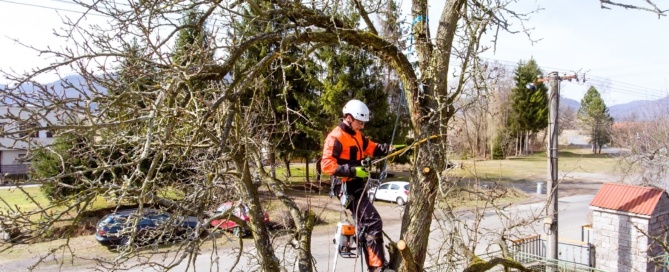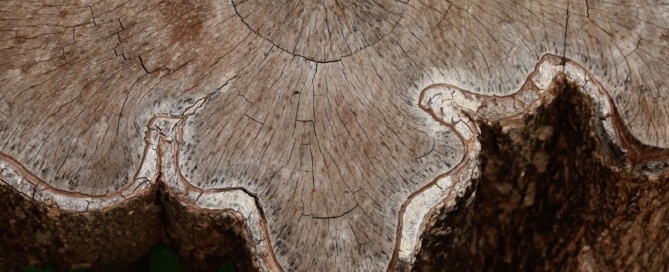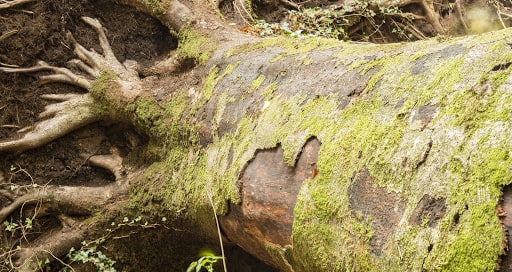Monthly Archives:
Why Your Tree Company Should Have Insurance
When it comes to hiring a tree company, there are many things to look for.
For starters, you should consider their experience and reviews of former customers. You’ll also want to learn about their specific services, like tree pruning or tree planting. And then, of course, you’ll want to consider the actual cost of their professional services.
But before you can move forward, there’s one more box that needs to be checked: insurance.
After all, if you hire a tree company without full insurance coverage, you’ll simply create a recipe for disaster.
In this article, we’ll break down the reasons why your tree company should always have insurance.
The Nature of Working with Mother Nature
First, it helps to understand the liability that comes with tree service work.
The tree care field is one of the most dangerous industries in the country. From extreme heights to electrical lines, workers are regularly exposed to high-risk situations. Tree care employees are also required to operate sharp and heavy equipment.
The job is even more dangerous after storms, when conditions are more slippery than usual.
Most importantly, Mother Nature is unpredictable. A dying tree branch, for example, can fall without warning. This is why it’s crucial to work with an experienced and knowledgeable tree service company like Friendly Tree.
Insurance Protects Both You and the Tree Company
Due to the dangerous nature of tree care, it’s critical to hire a company that has insurance. Specifically, they should have general liability insurance and workers’ compensation.
If a tree worker is injured on your property, workers’ compensation will cover their medical bills. But if they get hurt on your property and don’t have insurance, the company or worker can potentially sue you.
Plus, if you knowingly hire a company without insurance, your home insurance probably won’t pay the claim.
Insurance also protects against structural damages. For instance, if a tree worker prunes a tree and a heavy branch falls on your roof or car, their insurance will cover it.
Of course, no one wants accidents or injuries to happen. However, anything is possible, and it’s always best to be prepared.
Your Tree Company Should Also Have Certified Arborists and Tree Experts
In addition to insurance, your tree company should also have certified and licensed tree experts.
These experts have completed a high standard of training, licensing, and certifications. This ensures that they’ll get the job done — and do it right.
It also means that they have received proper safety training, thus reducing the risk of injuries and accidents.
Keep this in mind if another business, like a landscaping company, attempts to offer you tree services. While they might have insurance, their workers aren’t professional trained to handle the job.
Moreover, their insurance likely won’t cover the same scenarios tree workers encounter each day.
Call the Friendly Experts at Friendly Tree
As you can see, there are many reasons why your tree company should have insurance. It protects everyone involved, from the client to the business.
With Friendly Tree, you won’t have to wonder. We’re a fully insured tree company with years of professional experience. Since 1989, our team of certified arborists has proudly provided tree service in northern New Jersey.
We can’t wait to serve you, too. To learn more about our expert tree services, contact us at (973) 678-8888.
Tree Stump Grinding: What It Is and Why You Might Need It
As a homeowner, you’ve likely heard all about tree planting, pruning, and removal. Planting new trees, after all, is one of the best ways to enhance the natural beauty of your property. Pruning is an essential part of tree care, while removal is crucial for getting rid of old or dead trees.
But what about tree stump grinding? Some homeowners aren’t aware that it’s even necessary.
Let’s look at what tree stump grinding is and why you might need it.
Tree Stump Grinding 101
Tree stump grinding is a stump removal technique.
It involves a machine that grates the stump until it’s just below the soil. In some cases, the stump can be grinded as deep as 12 inches (or more) below the surface. This creates a discrete hole in the ground, letting you re-purpose the area.
The process of tree stump grinding takes just a few minutes. It also produces wood chip mulch, which is placed in the hole for 2 to 3 months. These wood chips steal nitrogen and other nutrients from the area before they start to decompose.
From there, you can spread the wood chips in areas like your garden, planting beds, and walkways. How’s that for resourcefulness?
While stump grinding leaves behind the roots, you won’t have to handle them. They’ll naturally break down in about 10 years.
Tree Stump Grinding Improves Aesthetics and Safety
Tree removal naturally leaves behind a stump. This leftover base can be visually unattractive, especially if your lawn is perfectly landscaped.
Mold, weeds, and insects could also grow on a tree stump and diminish your property’s curb appeal. Plus, if pests and diseases aren’t controlled, they can spread to other plants.
Most importantly, a tree stump is a safety hazard. Since most stumps are just a couple inches high, it’s easy to trip over one. This is dangerous for both kids and adults alike.
Tree stumps also make it difficult to properly mow the lawn. And even if a lawn mower makes it over the stump, there’s a major risk of machine damage.
Tree Stump Grinding vs. Tree Stump Removal
Tree stump grinding is just one technique for removing a tree stump. The other method is tree stump removal, which involves digging up the stump and its roots.
Compared to grinding, tree stump removal is more invasive. It takes more time, money, and powerful machines. Complete removal of a tree stump also leaves a bigger hole in the ground.
On the flipside, this hole offers more of a blank slate than stump grinding. It’s easier to “start over” if you totally remove the stump.
Call the Expert Tree Technicians at Friendly Tree
There isn’t a one-size-fits-all approach for dealing with a tree stump. The best choice depends on your property and what you plan to do with the area.
Luckily, with Friendly Tree, you’ll have personalized guidance every step of the way. Our professional tree technicians in New Jersey are ready to learn about your needs. We’ll also explain what tree stump grinding is and why you might need it.
When the time comes, we can also provide other tree services like tree trimming and tree planting.
For a friendly consultation with Friendly Tree, contact us at (973) 678-8888.
How Trees Help Retain (and Reduce) Stormwater Runoff
Trees offer countless environmental benefits. For example, they cleanse the air by producing oxygen and absorbing carbon dioxide. They also provide homes and food for animals like birds and squirrels. Needless to say, trees can bring immense value and advantages to a natural landscape.
But the benefits of trees don’t stop there. Trees also retain and reduce stormwater runoff, one of the biggest issues of urban and suburban areas. This means they can play a significant role in protecting the local environment.
Why Is Stormwater Runoff an Issue?
We all know rain is important. It replenishes our water sources, “feeds” rivers and lakes, and keeps our grass green and healthy. Rain also provides essential nutrients for agricultural crops and beautiful trees.
The problem is when rain becomes stormwater runoff. This happens when rainfall or melting snow flows over paved surfaces like roads, parking lots, and driveways. Since these surfaces are impermeable, they don’t soak up water. The result is a large volume of water flowing over ground surfaces.
Here’s why this can be bad news:
Flooding and Erosion
If rapid runoff flows into bodies of water, it can disrupt the natural flow and damage local animal habitats. It can also worsen the severity of flooding in urban and suburban neighborhoods.
Sewage Problems
Stormwater runoff can overwhelm local sewage systems, which are full of harmful pathogens and heavy metals. This presents serious public health concerns.
Pollution
When stormwater passes over paved surfaces, it picks up pollutants like pesticides, pet waste, lawn fertilizer, and byproducts from construction sites. The water then pushes these pollutants into local streams and rivers.
Excess Sediment
Similarly, fast-moving runoff forces sediment and residue into bodies of water. This can destroy natural habitats and block sunlight from underwater plant life.
Trees and Stormwater Runoff
While paved surfaces don’t mix well with rainfall, they’re essential components of developed neighborhoods. It’d be difficult to travel around town without surfaces like roads and sidewalks.
The solution? Plant new trees and take care of existing ones. Aside from beautifying our properties and streets, trees can manage stormwater runoff.
They can:
Retain Water
A tree provides a surface for rain to land on. Specifically, its leaves and bark can “intercept” and retain rainfall. This water will then evaporate or end up in the soil.
Decrease Erosion
Likewise, tree canopies intercept rainfall and reduce the risk of erosion.
Absorb Moisture
Water can also collect on fallen leaves. Eventually, the moisture will permeate the soil instead of flowing over paved surfaces.
Roots also absorb the water and aerate the soil, which soaks up moisture. This reduces the accumulation of runoff after a storm.
Plant New Trees and Reduce Stormwater Runoff
You can’t control the weather, but you can control how your property handles heavy rainfall. That’s why it’s important to plant trees to retain and reduce stormwater runoff.
However, managing runoff doesn’t stop at planting new trees. It also involves taking care of the trees you already have. By keeping your existing trees healthy, you can do your part in reducing stormwater runoff.
Friendly Tree is here to help. As a team of certified arborists, we offer professional tree planting services in New Jersey. We also know what it takes to help trees thrive and flourish.
To get a quote or schedule a consultation, contact Friendly Tree at (973) 678-8888.
How to Avoid Damaging Your Tree’s Roots
When you look at a tree, it’s easy to find something to admire: the robust trunk, the rustling leaves, and maybe even some dainty flowers. In the fall, the leaves morph into a spectacle of warm colors. In the winter, the branches become home to freshly fallen snow.
Needless to say, there’s a lot to appreciate when you look at a majestic tree.
But what about the roots?
While you can’t always see them, the roots are as admirable as the rest of the tree. The root system, which anchors the tree to the ground, supplies the tree with nutrients and water. It also helps drain and aerate the surrounding soil.
So, take the time to learn how to avoid damaging your tree’s roots. By following these safety precautions, you can help your beloved tree thrive for years to come.
Don’t Overwater
When it comes to watering, it can be tempting to literally “shower” a tree with love. After all, as a crucial component of tree care, water is essential for healthy roots.
Yet, it’s possible to overdo it. If a tree is overwatered, the roots will suffocate and fail to take up nutrients. The excess water can also promote the growth of dangerous microorganisms and cause root rot.
Overwatering is especially detrimental within the first two years of planting a tree. During this time, the root system is still establishing itself in the soil, so it’s important to go easy on the water.
If you’re not sure how often you should water your trees, talk to a certified arborist at Friendly Tree.
Add Mulch Properly
Mulch can do so much more than “prettify” your landscape. When used properly, mulch can insulate the soil and lock in root moisture. It also prevents soil compaction, ensuring that roots can efficiently absorb nutrients and water.
But like watering, there’s a wrong and right way to mulch. For example, piling a “mulch volcano” against the trunk will rob the bark and roots of oxygen. It also encourages the growth of disease-causing fungi and bacteria.
Instead, you should apply mulch from the tree’s root flare. Apply the mulch in a 3 to 10-foot circle around the base and use a rake to spread it out. Additionally, the layer of mulch should be no more than 2 to 4 inches deep.
Never Cut Roots Yourself
Whether you’re adding more plants or building near trees, you might consider snipping roots to make more space. However, much like pruning leaves, trimming roots should be left to the professionals.
Some roots are necessary for the tree’s water flow, nutrient delivery, and stability. If these roots are cut away, the tree can die or fall over.
A certified arborist can determine which roots are safe to trim. They can also consider other important factors, such as the best time of the year to cut roots. (Yes, it matters!)
Avoid Pouring Concrete
If you’re building a new structure or sprucing up your landscape, you might want to add concrete or stone near a tree. Unfortunately, this can severely damage your tree’s root system, even if it’s already established.
Concrete and stone will suffocate the roots, making it impossible to absorb oxygen, water, and nutrients.
If you must add concrete or stone, talk to a professional concrete company. They can work with an arborist to figure out the best way to add concrete without harming the roots.
Treat Your Roots Well with Friendly Tree
While every tree and property are different, these tips will help you avoid damaging your tree’s roots. If you have questions — or if you want personalized guidance — don’t hesitate to contact Friendly Tree.
Our New Jersey certified arborists can provide root safety tips based on the specific trees you own. We also offer a range of professional tree services, including tree pruning and tree planting.
To schedule a consultation or get a quote, contact Friendly Tree at (973) 678-8888.
Building Near Trees: Do’s and Don’ts
If you already have trees on your property, you might wonder about the best practices for adding new buildings. Perhaps you just bought land and you’d like to build a home. Or, maybe you’d like to renovate and expand an existing structure. Regardless of the situation, it’s important to know the do’s and don’ts of building near trees.
This will ensure the structure is built in a way that protects and preserves the structure of each tree. Besides, the last thing you want to do is damage the precious plants during construction!
Before starting your new project, consider these guidelines for building near trees.
DO…
Properly Prune Trees
When it’s time to bring in the construction equipment, you might want to prune your trees to make more space. But if you’re not 100% sure how to trim the branches, this simple move may cause significant harm.
That’s why it’s crucial to practice proper tree pruning techniques. Incorrect pruning can create “wounds” that increase the tree’s vulnerability to harmful insects. Plus, if sap leaks out the wounds, the tree will be robbed of nutrients.A certified arborist can make sure your trees are properly pruned before construction.
Control Nearby Traffic
Prior to building a new structure, make a plan to protect the tree and its roots.
It’s generally recommended to build a fence around the dripline, or the outermost circumference of the canopy’s edge. (This measurement is called the “dripline” because this is where water drips from the canopy to the ground). An even better move is to place the fence further out from the dripline.
By adding a fence around your tree, you can limit physical damage and keep construction machinery away.
Consider Designing Around the Tree
More and more architects are incorporating existing trees into homes, decks, and commercial buildings. This means the trees can stay practically untouched! For example, a deck can be built with a circular opening around a tree.
Of course, this depends on the type of tree and what you are planning to build. Your arborist, builder, and architect can work together to create a design that works for your needs.
DON’T…
Trim the Roots
You might be tempted to trim the tree’s roots in order to make more space. After all, the roots will simply re-grow around the building… right?
Well, not quite. An established root system is extremely complex. If certain roots are removed, the tree may lose its stability, resulting in damage or failure later on. Incorrect root cutting can also deprive the tree of nutrients and water.
Before snipping the roots, consult a professional tree service like Friendly Tree. A certified arborist will be able to determine which roots are safe to cut.
Add Concrete on Roots
It’s not recommended to add concrete (or stones) on an established root system. This can rob the roots of oxygen, nutrients, and water, which will ultimately lead to failure.
For best results, work with a professional concrete company. They’ll know how to handle the roots in a way that allows the tree to thrive.
Dig Trenches Too Close
When building a new structure, you’ll likely need an irrigation system. However, digging trenches within the dripline — or near the tree trunk — can interfere with almost half of the tree’s roots.
Fortunately, it’s possible to dig trenches without harming the roots. The best option is to dig them outside of the drip line, but you can also trench toward the trunk and tunnel underneath. A third option is to trench a third into the dripline and connect the trenches by tunnelling.
There are many do’s and don’ts of building near trees. But with a professional tree service like Friendly Tree, you can take proper precautions before starting construction.
Our certified arborists in New Jersey can make sure the process leaves your trees unharmed. With over 27 years of experience, our team knows precisely what to look for! We’re also happy to provide professional tree services, including tree removal, tree planting, and more.
Have questions? Contact Friendly Tree at (973) 678-8888 to get a quote or schedule a consultation.
Recent Posts
Archives
- August 2022
- June 2022
- May 2022
- April 2022
- March 2022
- February 2022
- January 2022
- December 2021
- November 2021
- September 2021
- August 2021
- July 2021
- June 2021
- April 2021
- March 2021
- February 2021
- January 2021
- December 2020
- November 2020
- October 2020
- September 2020
- August 2020
- July 2020
- June 2020
- May 2020
- April 2020
- January 2020
- December 2019
- November 2019
- October 2019
- September 2019
- August 2019
- July 2019
- June 2019
- May 2019
- April 2019
- March 2019
- February 2019
- November 2018
- September 2018
- August 2018
- July 2018
- June 2018
- May 2018
- April 2018
- February 2018
- September 2016
- August 2016
- July 2016
- June 2016
- May 2016
- April 2016
- November 2015
- August 2015
- March 2015







Recent Comments